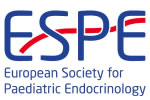ESPE2016 Poster Presentations Thyroid P2 (49 abstracts)
Peculiarities of Course and Therapy of Basedow–Graves’ Disease in Children in Different Age Groups
Galina Meraai , Hanna Bakhar , Tatsiana Kliuchnikava & Anzhalika Solntsava
Belorussian State University of Medicine, Minsk, Belarus
Suitably treatment of Basedow–Graves’ disease (BGD) provide the minimization of time to develop the medicamental remission. Research: determine clinical, laboratory particularities, evaluate efficiency of pharmaceutical treatment of BGD in children in different age groups. Materials and methods: 35 children with BGD were examined (4 boys, 31 girls): 1st group (Tanner 1) n=4, 7.5±0.65 years; 2nd – (Tanner 2–4) n=22, 12.32±0.31 years; 3rd – (Tanner 5) n=9, 15.56±0.24 years. Data of laboratory research (free thyroxine (FT4); TSH; thyroid peroxidase antibodyies (TPOAb); TSH receptor antibodies (TRAb)), thyroid gland’s ultrasound were analysed. Methods of variation statistics were used in statistical processing of results.
Results: Increase of thyroid gland was marked in children with BGD in manifestation: 1st – 172.75±19.52%, 2nd – 169.59±13.2%, 3rd – 117.74±6.89%, P<0.05. Elevation of FT4 levels (pmol/l) (1st – 95.51±27.61, 2nd – 57.9±5.97, 3rd – 71.94±22.57; n 10.0–23.2; P<0.05), TPOAb (ME/ml) (1st – 168.75±78.89, 2nd – 477.79±105.25, 3rd – 827.57±178.3; n<30; P<0.05), TRAb (ME/ml) (1st – 15.65±2.5, 2nd – 18.47±1.28, 3rd – 12.53±0.61; n<4; P<0.05), decrease TSH values (uME/ml) (1st – 0.03±0.01, 2nd – 0.04±0.01, 3rd – 0.03±0.01; n 0.25–5.0; P<0.05) were revealed in manifestation. Block-regimen treatment was used. Initial dose of antithyroid drug (Thiamazole) (mg/kg per day): 1st – 0.86±0.06, 2nd – 0.55±0.05, 3rd – 0.43±0.04, P<0.05. Maintenance dose of Thiamazole (mg/kg per day): 1st – 0.22±0.04, 2nd – 0.19±0.02, 3rd – 0.12±0.02, P<0.05. Duration of treatment (years): 1st – 3.25±0.85, 2nd – 2.89±0.32, 3rd – 1.33±0.24, P<0.05. Control values of FT4 in remission (pmol/l) (1st – 13.33±1.68, 2nd – 15.32±3.34, 3rd – 15.58±1.25, P<0.05), TSH (uME/ml) (1st – 3.75±0.98, 2nd – 3.32±0.64, 3rd – 2.6±0.68, P<0.05), TPOAb (ME/ml) (1st – 1.4±0.21, 2nd – 2.26±0.16, 3rd – 2.36±0.4, P<0.05). Negative correlation between patient’s age and Thiamazole dose was found (r=−0.39, P<0.05). Conclusions: more higher doses of antithyroid drug were used in the period of manifestation and medication remission of disease in prepubertal children compared to patients with Tanner 2–5; longer term of pharmaceutical treatment need to prepubertal children’s recovery comparison to pubertal aged patients.



